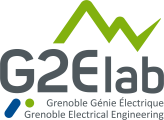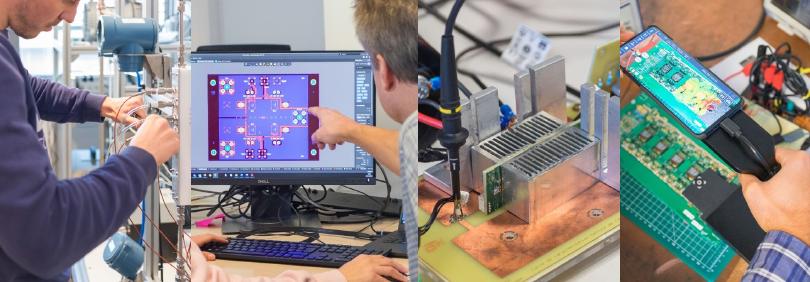The skills and expertise of G2Elab Power Electronics team are concentrated on 5 complementary pillars. Four of them inherit from past and long term activities and are related to design methodologies, conducted and radiated EMI modeling and characterization, hybrid integration and converters topologies and associated control strategies. Since 2019, a new promising research field corresponds to the last pilar and is dedicated to eco-design and circularity in power electronics.
Design methodologies for Power Electronics
We are contributing to this research field since many years developing tools, models and methods to support power electronics practitioners and designers. The following keywords are describing at best our contributions: automated design, design standard, design by optimization, life cycle assessment, dedicated indicators for adapted design. Today, the research in this area is characterized by two main activities:
- Design by optimization
- Modular and automated design

Converter topologies and associated control strategies
Converter topologies and associated control strategies are among the most specific research topics related to power electronics. G2Elab PE research group contributes to this research area for a long time. Main keywords characterizing our contribution are: resonant converters, multilevel converters, Multiple Active Bridge (MAB), converters for grid connection, converter clustering, including series connected power devices and gate driver supplies for very high voltage isolation. Below are today key topics on which we are working :
- Dual and Multiple Active Bridge
- Grid connected converters
- Modular converter and Power Converter Array (PCA)

Conducted and radiated EMI modeling and characterization
Conducted and radiated EMI modeling and characterization are important research areas for the group since early 90th. The team is active and skillful, with international recognition for its multiple contributions to the state of the art conducted EMI modeling in PE. More recently, with new faculty staff expertise on radiated EMI, we are investigating more on radiated EMI applied to PE. Keyword characterization at best our contributions are: PE converter EMC modeling, standard and regulation protocol for EMC characterization, 3D heterogeneous cable modeling, modeling of radiated EMI in conversion systems. Below are today contributions:
- EMC analysis at system level
- EMC studies linked to WPG devices and VHF conversion techniques.
- Modeling of HF current impacts on human being.

Hybrid integration
Since the early 90th, we are developing an important research activity dedicated to monolithic and hybrid integration in order to improve the implementation performance of active devices. We are developing new device and packaging concepts, coupling the design of the devices, the package and the conversion system. Taking advantage of technology options and new opportunities, we are targeting high power density integrated solutions, and/or modular, reconfigurable and reparable packaging solutions. Today we are not anymore involved in the design and prototyping of monolithic power devices. Our main keywords are: usage of material and processes for integration, power module, gate drivers, isolation, electro-thermo-mechanical characterization, 3D architecture for power modules, modular and standardized power module concepts, reparable power modules. Read more on this topic.
- Power module technologies for higher performance and durability
- Electro-thermal management of power devices
- Packaging of WBG power devices for enhanced operating range and performances (switching frequency, max operating temperature, current and voltage)

Ecodesign and circularity in power electronics
Last born research topic in the group, we are engaged in developing a power electronics technology more compatible with planetary boundaries. With our strong expertise in traditional design of power converters, together with the knowledge on materials and technologies (check above research topics), we have a good background to focus on more sustainable power electronics. With some supports from colleague of G-SCOP lab, we are ramping on Life Cycle Assessment (LCA), ecodesign methods and tools, developing new indicators and design rules.
Today we are mostly focused on component, subsystem and converter system design for circularity, taking into account environmental impacts over the entire life cycle of the PE system. Our objectives are to support decision making at the earliest stage possible of the product design (even at specification stage). We are also committed to make our community aware about power electronics environmental burden and the absolute need to take environmental impacts into consideration in the design and manufacturing.
- Tools, methods, indicators for ecodesign and circularity
- Design guideline and indictors for circularity
- Characterization and implementation of new materials for ecodesign and more sustainable PE
- Sustainability assessment of PE

Main research topics
- Design methodologies
- Converter topologies and associated control strategies
- Modeling and characterization of conducted and radiated EMI
- Hybrid integration
- Ecodesign and circular economy


